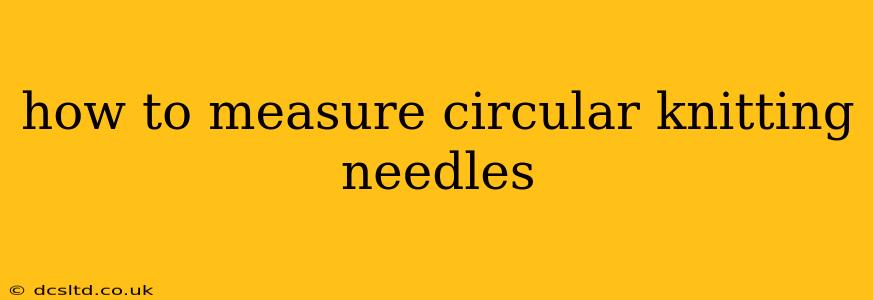Circular knitting needles are a staple for many knitters, offering versatility and ease for creating seamless garments and projects. However, knowing how to accurately measure them is crucial for selecting the right size for your yarn and pattern. This guide will walk you through various methods for measuring circular knitting needles, addressing common questions and concerns.
What are the Different Parts of a Circular Knitting Needle?
Before diving into measuring techniques, let's clarify the needle's components. A circular needle consists of two pointed tips connected by a flexible cable. Understanding these parts helps in accurate measurements:
- Tips: These are the pointed ends where the yarn is manipulated. The size of the tip is usually indicated on the needle itself.
- Cable: The flexible cord connecting the two tips. The cable's length is a critical factor for project selection. It’s measured separately from the tips.
How to Measure the Size of the Needles (Tip Size)?
The most important measurement is the needle size, which dictates the thickness of the needles and therefore the finished fabric's gauge (stitches per inch). This size is usually marked directly on the needle itself, often with a number and a letter (e.g., US 8, 5mm).
- Check the markings: Look carefully at the needle's shaft. The size is almost always stamped or etched onto the metal.
- Use a needle size gauge: If the markings are unclear or missing, a needle size gauge is a handy tool to determine the size precisely. These gauges feature various sized holes corresponding to different needle sizes. Inserting the needle into the correct hole will identify its size.
- Measure the needle's diameter: While less common, you can use a ruler or caliper to measure the diameter (thickness) of the needle directly. This is particularly useful for vintage needles or those lacking markings.
How to Measure the Length of the Cable?
The cable length is equally important, especially for large projects. A too-short cable can lead to awkward knitting and limitations. A too-long cable can result in excess weight and tangling. Measuring the cable is straightforward:
- Lay it flat: Gently straighten the cable as much as possible, avoiding unnecessary stretching or bending.
- Measure from tip to tip: Use a tape measure or ruler to measure the length of the cable from the tip of one needle to the tip of the other. This gives you the total length of the cable including the needles.
- Measure the cable only: If you need to know the length of just the cable, you can measure it separately after removing the needles (if possible).
How Long Should My Circular Knitting Needles Be?
The ideal length of your circular needles depends entirely on your project. Longer cables are suitable for larger garments, while shorter ones are better for smaller items or those with intricate patterns. Here's a general guideline:
- Small projects (hats, scarves, etc.): 16 inches (40 cm) or less.
- Medium projects (sweaters, cardigans): 24-40 inches (60-100 cm).
- Large projects (afghans, blankets): 40 inches (100cm) and beyond.
What about Interchangeable Circular Needles?
Interchangeable circular needles utilize separate tips that are attached to different length cables. Measuring these is similar to the process outlined above, but you'll need to measure each part separately. The size of the tip is indicated on the needle, while the cable length is measured as described earlier.
How to Measure Circular Knitting Needles Without a Ruler?
In a pinch, you can try to compare your needles to needles you know the size of. However, this method is less accurate and should only be used if more precise tools are unavailable.
Remember, accurate measurements are crucial for consistent results in knitting. Using the correct size needles and cable length ensures that your finished project matches the pattern's specifications and looks its best.
